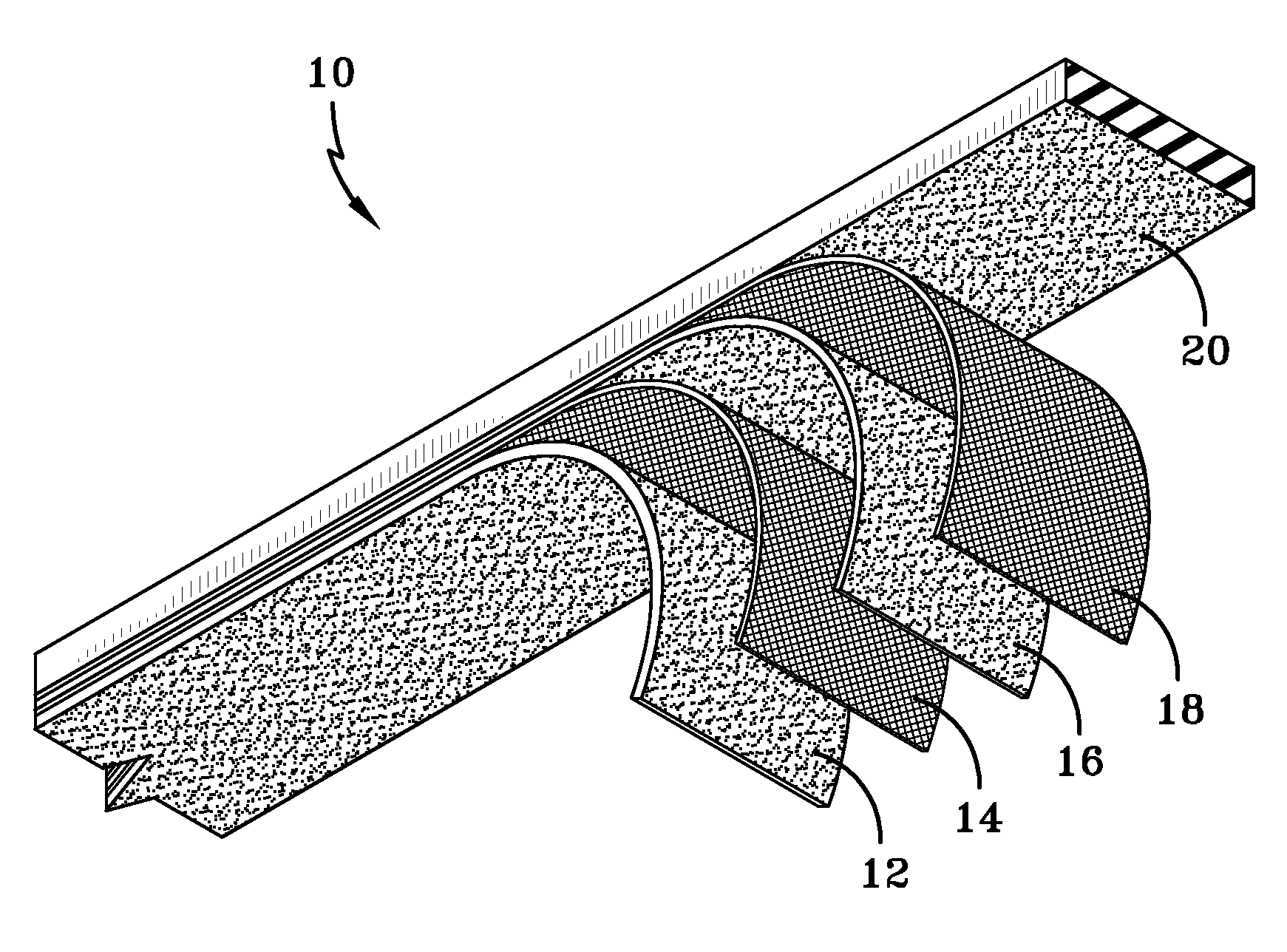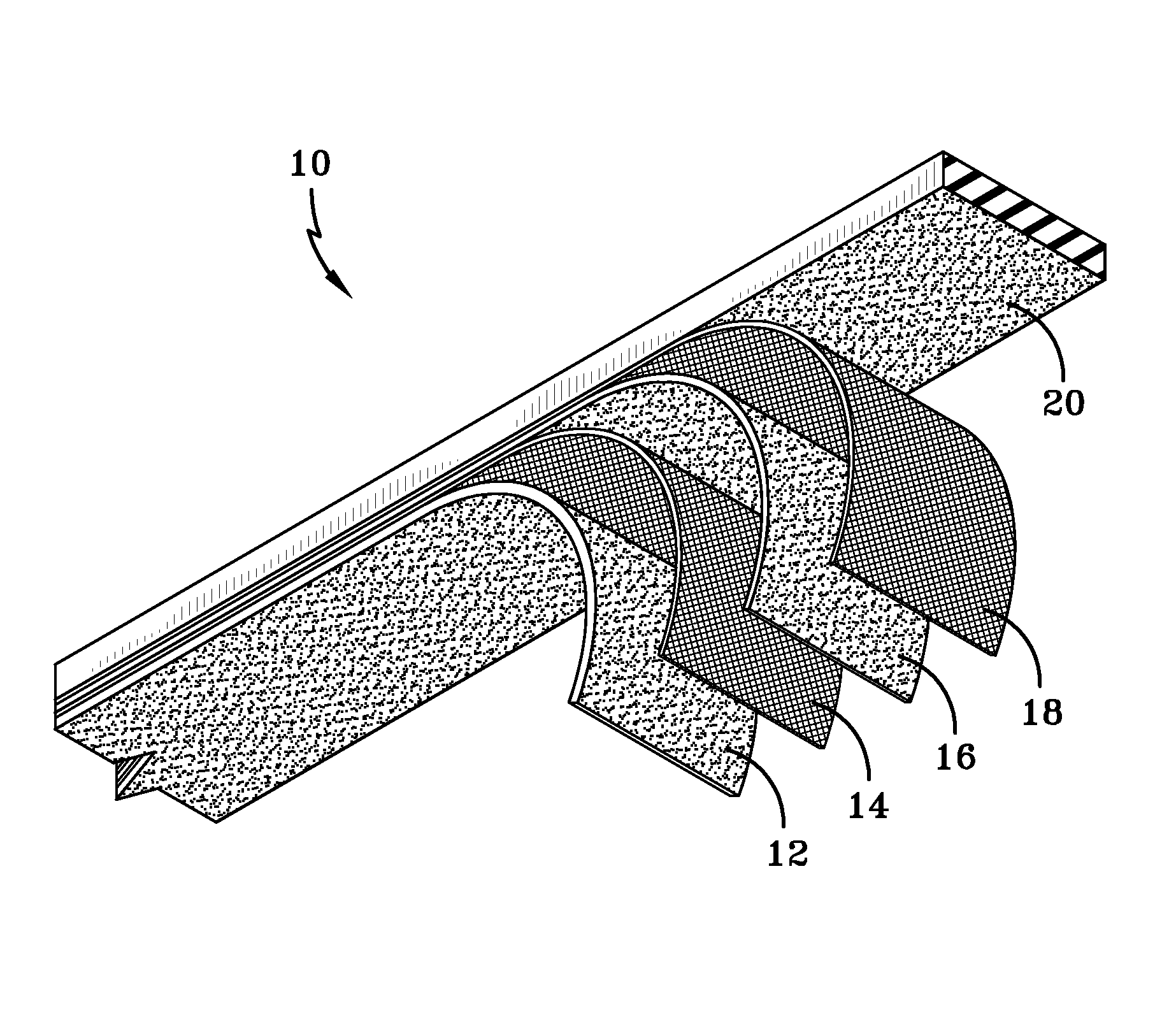Conveyor belt
a conveyor belt and belt body technology, applied in the field of conveyor belts, can solve the problems of labor-intensive manufacturing of conveyor belts, inadequate ply adhesion, and insufficient physical properties of conveyor belts, so as to improve carcass ply adhesion, reduce labor requirements, and reduce labor.
- Summary
- Abstract
- Description
- Claims
- Application Information
AI Technical Summary
Benefits of technology
Problems solved by technology
Method used
Image
Examples
example 1
[0022]In this experiment a fabric carcass which was suitable for reinforcing conveyor belts was prepared. In the first step of the procedure, a bond plastisol composition was made by mixing 200 grams of emulsion grade polyvinylchloride (PVC) into a liquid plasticizer solution containing 86 grams of diisononylphthalate (DINP), 6 grams of epoxidized soybean oil (ESO), and 6 grams of calcium / zinc stabilizer (Mark 3079).
[0023]Subsequently, 1.2 grams of Lanxess bonding agent 2001N (containing 40 weight percent 2,4-toluene diisocyanate / 2,6-toluene diisocyanate mixture (TDI) in dibutyl phthalate) was mixed into 20 grams of the bond plastisol composition which was previously made. Then, this composition was evenly applied to both sides of two 6.5 inch by 6.5 inch (16.5 cm by 16.5 cm) squares of a polyester fabric (35.5 ends per inch of 2000 denier polyester yarn in the warp direction and 10.5 picks per inch (4.1 picks per cm) of 4000 denier polyester yarn in the weft direction).
[0024]Then, ...
example 3
[0028]In this experiment another carcass construction was made for comparative purposes. The procedure used a bond plastisol which was made by 2600 lbs (1180 kg) of emulsion grade polyvinylchloride (PVC) to a vessel containing 1119 lbs (508 kg) of diisononylphthalate (DINP), 77.8 lbs (35.3 kg) of epoxidized soybean oil (ESO), and 77.9 lbs (35.3 kg) of calcium / zinc stabilizer (Mark 3079). Then, 2.2 pounds (1.0 kg) of 6% by weight Lanxess Bonding Agent 2001N (40 weight percent 2,4-toluene diisocyanate / 2,6-toluene diisocyanate mixture (TDI) in dibutyl phthalate) was added to 35 pounds (15.9 kg) of the bond plastisol previously made just before adding it to a charge tank. This step was repeated as the mixture was used in the process. The bond paste was then pumped to a dip tank in which a polyester fabric was continuously fed to the dip tank where it is immersed and then scraped to remove excess plastisol. The tension on this fabric was less than 6 pounds per inch of width (1.071 kg per...
example 4
[0032]In this experiment a complete conveyor belt was built utilizing the principals of this invention. The procedure used a bond plastisol which was made by mixing 2600 lbs (1180 kg) of emulsion grade polyvinylchloride (PVC) to a vessel containing 1119 lbs (508 kg) of diisononylphthalate (DINP), 77.8 lbs (35.3 kg) of epoxidized soybean oil (ESO), and 77.9 lbs (35.3 kg) of calcium / zinc stabilizer (Mark 3079). Then, 2.2 pounds (1.0 kg) of 6% by weight Lanxess Bonding Agent 2001N (40 weight percent 2,4-toluene diisocyanate / 2,6-toluene diisocyanate mixture (TDI) in dibutyl phthalate) was added to 35 pounds (15.9 kg) of the bond plastisol previously made just before adding it to a charge tank. This step was repeated as the mixture was used in the process. The bond paste was continuously applied to the surface of a polyester fabric. The excess plastisol was removed by a roller. The polyester fabric was woven using 35.5 ends per inch (14.0 ends per cm) of 2000 denier polyester yarn in the...
PUM
| Property | Measurement | Unit |
|---|---|---|
| temperature | aaaaa | aaaaa |
| pressure | aaaaa | aaaaa |
| temperature | aaaaa | aaaaa |
Abstract
Description
Claims
Application Information
 Login to View More
Login to View More - R&D
- Intellectual Property
- Life Sciences
- Materials
- Tech Scout
- Unparalleled Data Quality
- Higher Quality Content
- 60% Fewer Hallucinations
Browse by: Latest US Patents, China's latest patents, Technical Efficacy Thesaurus, Application Domain, Technology Topic, Popular Technical Reports.
© 2025 PatSnap. All rights reserved.Legal|Privacy policy|Modern Slavery Act Transparency Statement|Sitemap|About US| Contact US: help@patsnap.com


